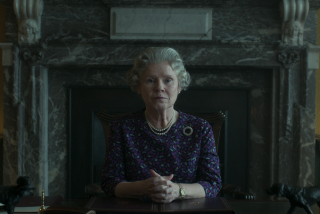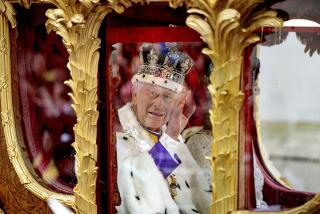A Princess Remembers the Fall of British India : RAJ <i> by Gita Mehta (Simon & Schuster: $18.95; 444 pp.)</i>
- Share via
“Providence,” wrote Rudyard Kipling, “created the Maharajahs to offer mankind a spectacle.” That spectacle flourished for several millennia within India, prior to the establishment of imperial rule in 1858 by the British Crown. Despite successive waves of foreign invasions and migrations over many centuries, and despite the passing and re-formation of dynasties, the institution of Indian kingship (as old as the “Mahabharata” itself) remained constant and ubiquitous throughout the subcontinent until the mid-20th Century.
At the time of the first British colonies, India was ruled by 565 princely states. These states were most remarkable, perhaps, for their multiplicity and diversity. The very palaces and forts of the dynastic rulers varied remarkably, as well, in size, architecture, history and occupation: from a chieftain’s well-appointed, tapestried tent to a maharajah’s 400-room marble palace housing thousands of servants and retainers, rose-water-filled swimming pools, exotic zoos, squash courts, modern movie theaters and great, gilded durbar halls.
Among the princely rulers were hedonists and ascetics, scholars and sportsmen, tribal chieftains and Oxford graduates, despots and reformers. However, regardless of their wealth, religious background, or aptitude for leadership, most royal leaders of British India initially welcomed imperial rule, for one of the Crown’s first acts was to freeze the borders of many kingdoms, thus providing a security and tenure heretofore unknown to the rulers and their predecessors. But there was a stiff price to pay for such security: British paramountcy, a system whereby Indian kings became beholden not to their own rule or people, but to the British Raj, as embodied in the person of the viceroy, and as directly overseen, in each kingdom, by a resident officer.
Suddenly India’s powerful kings were demoted to “princes” and “native chiefs,” and their vast and ancient domains regarded simply as princely or native states that were subjected to exorbitant taxation by the British Crown. During a 90-year period, India’s rulers submitted to a deliberate and gradual erosion of their power, to the threat of divestment and forced abdication of their thrones. Often they were ousted or exiled on the grounds of “princely misconduct” (such as an indiscreet or scandalous sexual liaison), or because they were accused of treason, sedition, or disloyalty to the Crown.
No wonder, then, when the seeds of nationalism began to propagate in the 1920s, many of India’s most powerful rulers found themselves in an intractable political dilemma. They felt torn between their often tenuous and ambivalent loyalty to the British Raj and their own loyalty to their traditions and their subjects, who were beginning to demand “home rule” and a more democratic governance.
Gita Mehta’s fine novel, “Raj,” accurately documents and compellingly dramatizes the maelstrom of allegiances and conflicting loyalties that beset the Hindu, Muslim and Sikh rulers of princely India. Spanning the era from Queen Victoria’s Diamond Jubilee in 1897 (Editor’s note: See Page 6) to partition and independence in 1947, Mehta chronicles the British Raj’s effect both upon the princely states in general, as well as upon the personal life of an Indian princess, Jaya Devi.
Born and reared in the desert kingdom of Balmer, Princess Jaya is guided by conflicting influences throughout her childhood: by her deeply religious mother and by her modern, anti-British father. Contradictory forces direct every aspect of her home life and schooling: Jaya studies Sanskrit and the ancient Rajput laws of sovereignty with the palace guru, womanly demeanor with the purdah ladies in the zanana (women’s quarters of the palace), current events with her austere and fiercely nationalistic tutor and polo with the British political officer assigned to Balmer.
A series of tragic events leads, eventually, to Jaya’s departure from Balmer and to her arrival, as a teen-age bride, in the Kingdom of Sirpur. The princess’ life here, too, is contradictory and confusing. Her new husband, Prince Pratap, an Oxford-educated playboy, expects his bride to become Westernized enough to don red nail polish and risque saris, yet he demands that she conform to his traditional expectations of an appropriately submissive and reticent Hindu wife. Prince Pratap, and his brother the Maharajah Victor, energetically court the favors of the British Raj, while openly indulging their tastes for foreign actresses, Indian prostitutes, for extravagant banquets and lavish balls, for expensive cars and planes.
Early in her marriage, Jaya recognizes the tyranny of the Raj, as it renders her husband and brother-in-law politically impotent and embittered, and as it encourages the excesses of other rulers, whose only permissible act of defiance seems to be to outdo the exhibitionism and materialistic grandeur of English royalty. Jaya’s exile from Balmer, and her estrangement from her husband, allow her to gain an objectivity and clarity rare among her friends and associates. Eventually, she comes to see herself, her adopted kingdom and British India as being painfully compromised: All three flounder toward an ideal of self-respect and autonomy, yet each remains dependent upon the good offices of either husband, resident officer or British Crown.
Regardless of her clear political vision, Jaya’s personal evolution is clouded by fear and uncertainty of self, by her reluctance to challenge tradition. Nonetheless, her gradual personal transformation is convincing and poignant. Ultimately, as Regent of Sirpur, Jaya learns how to act on her own behalf, even as she acts on behalf of the people she rules. Adroitly, the author parallels the heroine’s ascendancy to personal power with the decline of autocracy and British rule.
Many distinguished and capable British authors have depicted and examined life in India under the British Raj (Kipling, Forster, John Masters and Paul Scott, to name but a few), but their views are inescapably British and all too often reflect the prejudices of imperialism. How necessary and instructive it is to hear the story of British colonial rule from descendants of those who were subjugated by it, damaged by its injustices. Doubly refreshing, then, is Mehta’s ambitious and successful book, for it allows its readers a fascinating and vivid glimpse into one Indian woman’s long moment in history, as she charts her own course and as she witnesses the painful evolution of the most populous fledgling democracy in the world.
More to Read
Sign up for Essential California
The most important California stories and recommendations in your inbox every morning.
You may occasionally receive promotional content from the Los Angeles Times.












